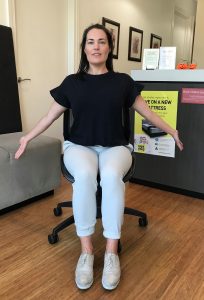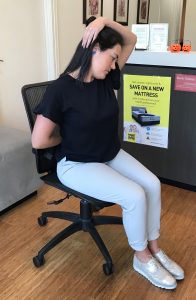Written by: Emily Gill (Osteopath) Osteopathy on Canterbury and Complimentary Therapies
Computers and technology are currently ruling the roost in our lives. Children are using them at school, more people are in office jobs, small businesses use them for sales and even health practitioners use them for note taking. And yes whilst they do make our lives a lot easier, they are also not doing wonders for our bodies, especially our necks.
The longer you sit and work at a computer, the more uncomfortable you become and this can therefore lead to worsening posture and micro-trauma to your muscles, ligaments and other structures around your neck. Therefore the number one tip I want to give you for prevent neck pain with your computer use is to take regular breaks. Every 30 minutes ideally, get up from the computer; complete a few stretches, walk to the kitchen & get a glass of water, use the bathroom, speak to a colleague or simply stand up count to 30 and sit back down again.
The way that our computer station is set up ergonomically will also have an impact on your likelihood of having neck pain. Below are a few quick tips you can check for yourself to make sure you are in the best possible posture when using a computer or laptop. A lot of work places will also have an option for you to have a professional ergonomic assessment, ask your boss if you think you would benefit.

Tips for Improving Posture at Work
Desk
- Sit to stand desks are great, aim to begin with 30:70 sit to stand ratio to begin with during a work day, and as you are more comfortable with the desk you my like to aim for a 50:50 split
- Standing height desk should be high enough for your wrists to be comfortable at the keyboard and not too extended so we don’t put any undue pressure on our wrists. This height will be approximately 5cm lower than your elbows when they are tucked by your side with hands on keyboard
Computer – desktop
- Back and neck relaxed with elbows close to the body and bent at an angle of approx. 90-120 degrees to keep wrists and hands straight
- Eyes level with the top 1/3 of the screen so that you look slightly down towards your work
- Keyboard and mouse within close range so you don’t feel as though you are reaching
- Position away from windows to avoid glare
- Wear glasses if indicated to avoid eye strain
Computer – laptop
- Ideally have the laptop on a raiser, again so that you eyes are level with the top 1/3 of the screen
- Use an external keyboard and mouse
- Angle the screen to reduce bending our head and neck forwards
- Limit use on laptop keyboard, especially when not sitting at your desk. Couches and laptops for work are not recommended.
Chair
- Hips higher than knees, slight downward angle of your thighs towards the floor, this will come from the height of the actual chair as well as the inclination of the seat rest.
- Knees should protrude approx. 5cm from edge of the seat rest, so you can feel the edge of the seat rest against the back of your thigh not directly behind the knee
- Lumbar (lower back) support – raise the back section of the chair so the support actually sits in to the small of your lower back
- Feet firmly on the ground, may use the aid of a foot rest fi required
- Elbows tucked by your side and approx. 5cm above the height of the desk
So next time you sit (or stand) at your desk to work at your computer, think about these tips and reassess your work station. You can also regularly stretch your neck; keep yourself healthy with good nutrition and regular exercise (both cardiovascular and resistance training) and seek advice or treatment from a health professional to keep you on track and feeling good.
See below some images on how to perform some simple neck stretches that you can include in your daily routine.


Emily Gill, Osteopath at Osteopathy on Canterbury and Complimentary Therapies, writes this article. All information is recommended only and is directed at the general population. Should you need further assistance please speak to your health professional and/or work place for further information
